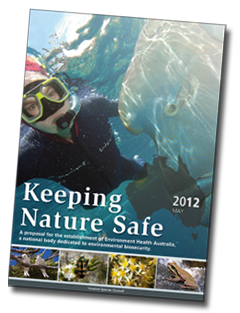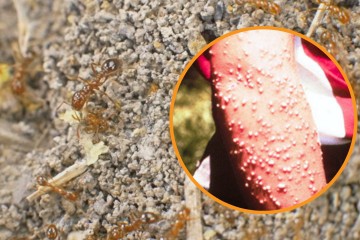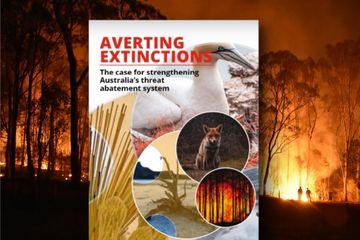 With a continued high rate of new invasive species arriving and establishing in Australia, it is clear we need a more concerted focus on environmental biosecurity priorities.
With a continued high rate of new invasive species arriving and establishing in Australia, it is clear we need a more concerted focus on environmental biosecurity priorities.
To help address this need, the Invasive Species Council, supported by 30 environmental NGOs, has proposed to the Senate inquiry the establishment of a national body – Environment Health Australia (EHA) – to bring together major participants in environmental biosecurity, effectively involve the community sector, and facilitate cross-jurisdictional, cross-sectoral collaboration.
One-third of the >80 Senate inquiry submissions supported the establishment of a body like Environment Health Australia. Just two were opposed to the idea (the federal government and the Nursery and Garden Industry Association), and the others didn’t mention the idea.
One of the reasons that agricultural biosecurity is considerably more advanced than environmental biosecurity is the existence of Plant Health Australia (PHA) and Animal Health Australia (AHA). The 2008 biosecurity review noted they ‘have been integral to Australia’s biosecurity success’.[1] EHA is proposed as their environmental equivalent. Formed in 1996 (AHA) and 2000 (PHA), they have been very effective in improving Australia’s preparedness against high priority risks for agricultural industries.
A similar collaborative approach with similar levels of public funding (see Tables 1 and 2 below), focused on environmental biosecurity priorities and with meaningful involvement of the community sector, would greatly strengthen Australia’s capacity for environmental biosecurity. Plant Health Australia recognised the advantages of establishing a similar independent body ‘to create the framework and coordination for partnerships to operate’ for environmental purposes.[2]
Interested in supporting Environment Health Australia? You too can endorse the proposal.
Proposed functions and membership of EHA
The functions of the proposed EHA could include the following:
- Improve Australia’s biosecurity preparedness, eg. develop contingency plans and surveillance protocols, and conduct foresighting
- Strengthen the foundations of environmental biosecurity by promoting more ecologically informed approaches to biosecurity
- Promote effective responses to environmental invasions, eg. develop emergency response plans and facilitate training
- Enhance community awareness, vigilance and action in biosecurity
- Improve environmental biosecurity capacity,eg. identify and prioritise research and capacity needs and act as a clearing house for information
- Improve coordination and collaboration between jurisdictions, agencies and sectors.
- Monitor and report on progress in environmental biosecurity.
Potential members of EHA include:
- Federal, state and territory government environment and biosecurity agencies
- Environmental NGOs
- Indigenous land management organisations
- Natural resource management and conservation land management organisations
- Research institutions focused on biosecurity and ecology
- Professional bodies for people involved in environmental biosecurity (eg. weed societies, Ecological Society of Australia, Australasian Plant Pathology Society)
- Environmental and allied primary production industry bodies (eg. in ecotourism, environmental restoration, zoo and wildlife industry, botanic gardens).
Not an industry body
In recognition of the need to improve environmental biosecurity and the benefits brought by Plant Health Australia and Animal Health Australia, there have been proposals to expand their functions to include a focus on environmental issues.[3] However, for the following reasons we consider that bolting on environmental functions to the existing structures will not work to achieve the ecological, collaborative and coordinated approach needed for environmental biosecurity.
Plant Health Australia and Animal Health Australia are not-for-profit companies to coordinate government-industry partnerships to protect plant and animal industries. The industry membership of these bodies is understandably unlikely to accord environmental threats the priority and specific focus they require. It is difficult to see how the wide variety of stakeholders in the community sector could assume an effective partnership role in these organisations, and there has been no consultation with the community sector about this.
The ‘one biosecurity’ approach to biosecurity advocated by the 2008 biosecurity review requires recognising differences as well as similarities to biosecurity for industry and environmental purposes. Although many invasive species affect both business and environmental assets and warrant a joint approach, protecting nature differs in many important ways from protecting industry assets. A dedicated focus by an environmental body is needed rather than a bolt-on to existing bodies.
Funding
The major impediment to the proposal for EHA seems to be financial. But failing to invest properly in biosecurity prevention is false economy given the high costs of invasive species (both in economic and biodiversity terms) and governments have invested millions of dollars in the industry bodies and continue to do so.
Given that improving environmental biosecurity is so critical to conservation and that it lags far behind that for industry, there is a strong rationale for governments to invest in a body focused on environmental priorities. Other potential sources of funding include development offsets, industry levies under the ‘polluter pays’ principle, philanthropic funding and memberships and in-kind support.
Over the 5 years to 2012-13, the federal government provided $22.6 million funding to Animal Health Australia and Plant Health Australia, an average $4.5 million/year (Tables 1 and 2 below). This includes membership subscription funding of $10.2 million and project funding of $12.4 million. State and territory governments in combination provided an equivalent level of membership funding, ie. $10.2 million over the 5 years to 2012-13. (They presumably also provide some project funding.) Industry paid a third of total membership funding ($10.2 million over 5 years).
Given how far environmental biosecurity lags agricultural biosecurity and the huge investment by taxpayers in agricultural biosecurity through Animal Health Australia and Plant Health Australia (as well as other ways), there is good reason for the federal government to invest at least a similar level ($20 million over the next 5 years) in the proposed Environment Health Australia. A higher level of funding is justified given how much work needs to be done to achieve the same level of preparedness as the industry sector.
Most groups in the community sector have limited capacity to contribute financially but EHA could potentially leverage considerable in-kind contributions. [4] The community sector already contributes substantially to management of invasive species threats. Respondents to a national survey of organisations managing invasive species threats included 485 community organisations providing $61 million of effort per year. By extrapolation, the annual value of the community effort was conservatively estimated to be in the order of $600 million and is likely to be much higher. [5]
Table 1: Commonwealth funding for Animal Health Australia, 2008-09 to 2012-13 [6]
|
Financial Year |
Membership funding ($M) |
Project funding ($M) |
|
2012-13 |
1.30 | 0.88 |
|
2011-12 |
1.30 |
0.99 |
|
2010-11 |
1.24 |
1.14 |
|
2009-10 |
1.27 |
2.08 |
|
2008-09 |
1.27 |
1.09 |
| 5 year total | 6.38 |
6.18 |
Table 2: Commonwealth funding for Plant Health Australia, 2008-09 to 2012-13 [7]
|
Financial Year |
Membership funding ($M) |
Project funding ($M) |
|
2012-13 |
0.78 |
1.96 |
|
2011-12 |
0.75 |
3.76 |
|
2010-11 |
0.75 |
0.23 |
|
2009-10 |
0.75 |
0.12 |
|
2008-09 |
0.75 |
0.22 |
|
5 year total |
3.78 |
6.29 |
More info
Environment Health Australia >>
Senate inquiry: Invasive Species Council submission and case studies >>
Senate inquiry into preventing new invasive species >>
[1] Beale R, Fairbrother J, Inglis A, Trebeck D. 2008. One Biosecurity – a working partnership, Independent review of Australia’s Quarantine and Biosecurity Arrangements, Report to the Australian Government
[2] Plant Health Australia. 2008. Submission to quarantine & biosecurity review.
[3] For example: Beale R, Fairbrother J, Inglis A, Trebeck D. 2008. One Biosecurity – a working partnership, Independent review of Australia’s Quarantine and Biosecurity Arrangements, Report to the Australian Government
[4] Many industry groups also contribute very little funding to the industry groups, with some bodies paying just $1500 annually for membership of Plant Health Australia.
[5] Invasive Species Council. 2013. Research, analysis and extension project: additional analysis report. Unpublished report.
[6] Minister for Agriculture, Fisheries and Forestry. 2013. Government Funding: Animal Health Australia and Plant Health Australia. Question No. 2668 (asked on 14 January 2013)
[7] Minister for Agriculture, Fisheries and Forestry. 2013. Government Funding: Animal Health Australia and Plant Health Australia. Question No. 2668 (asked on 14 January 2013)




